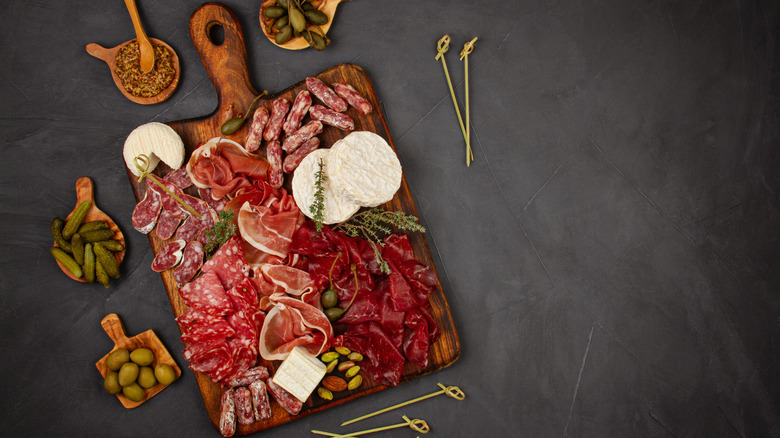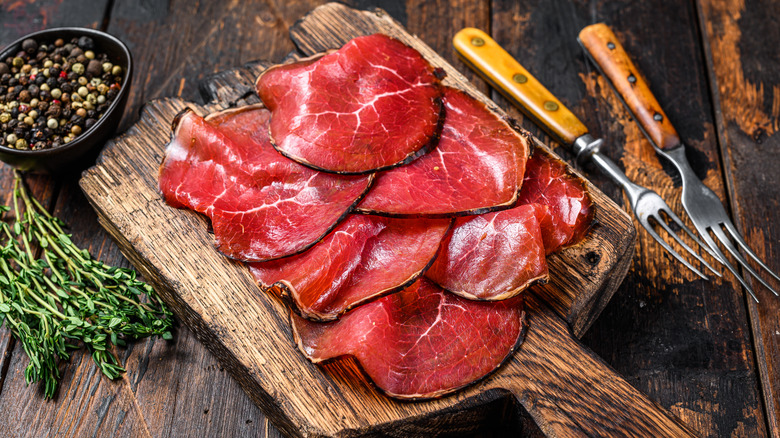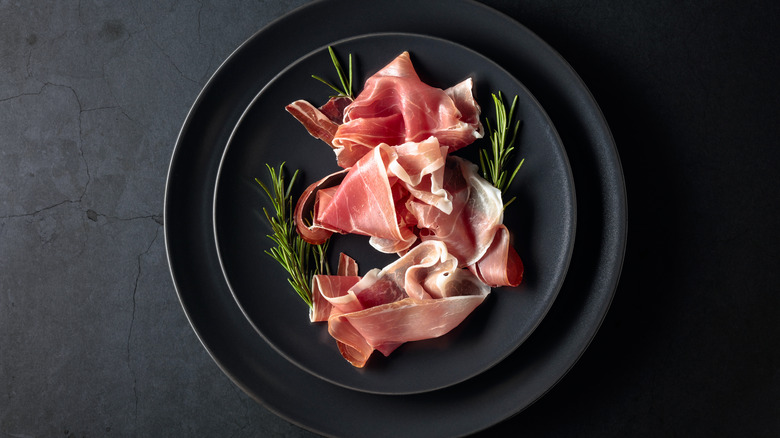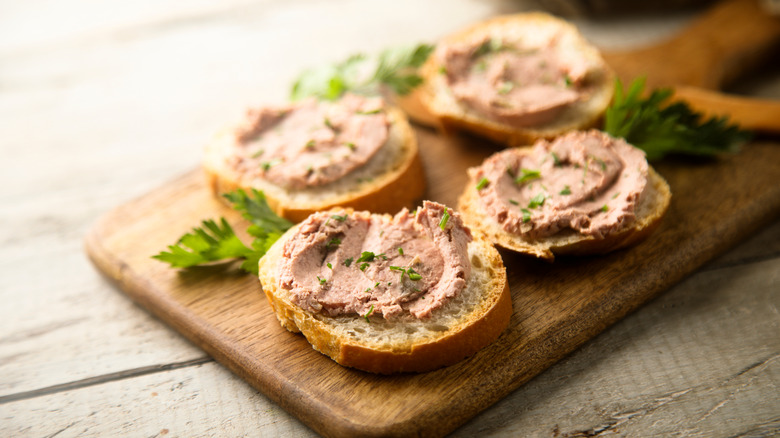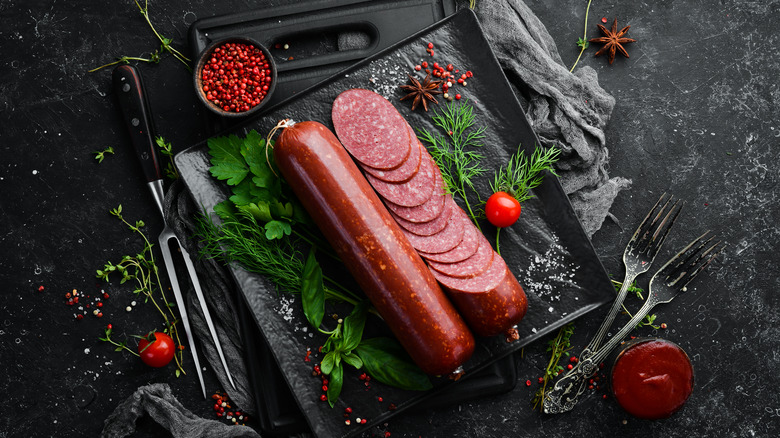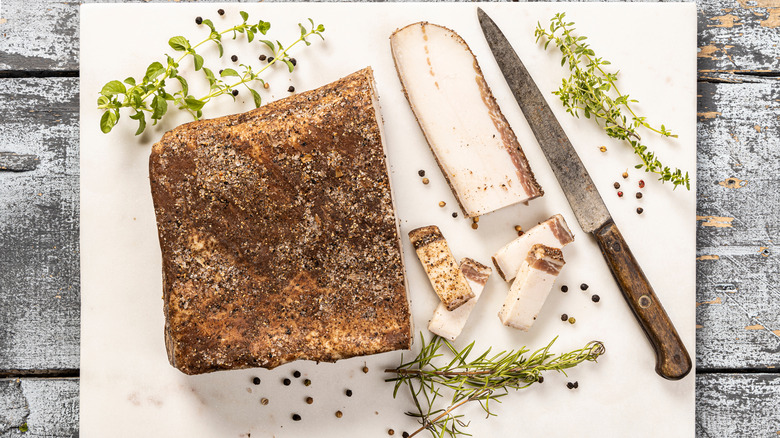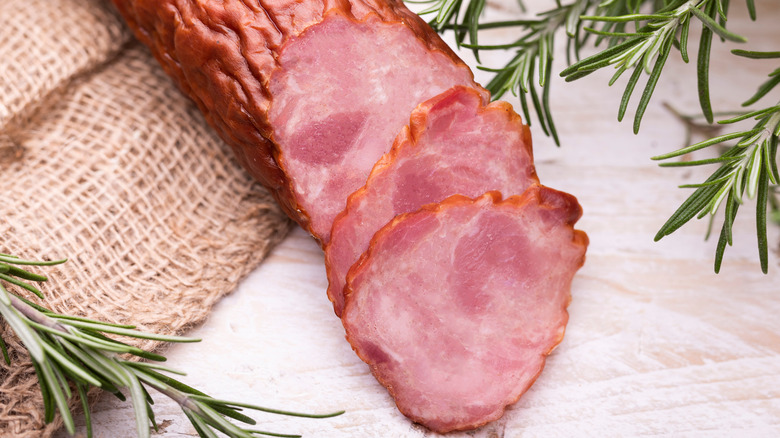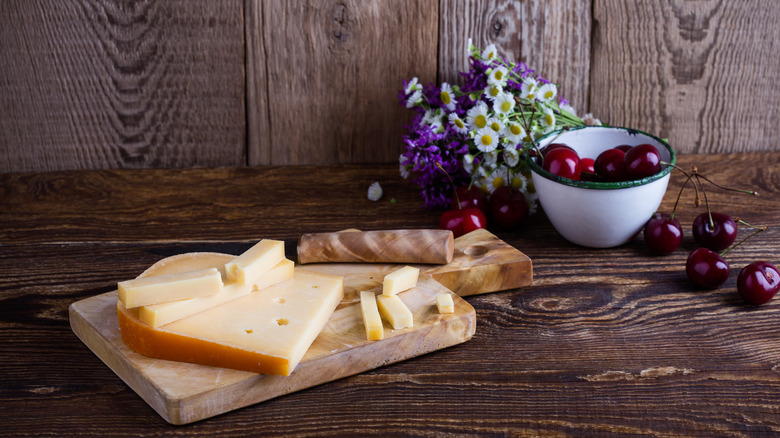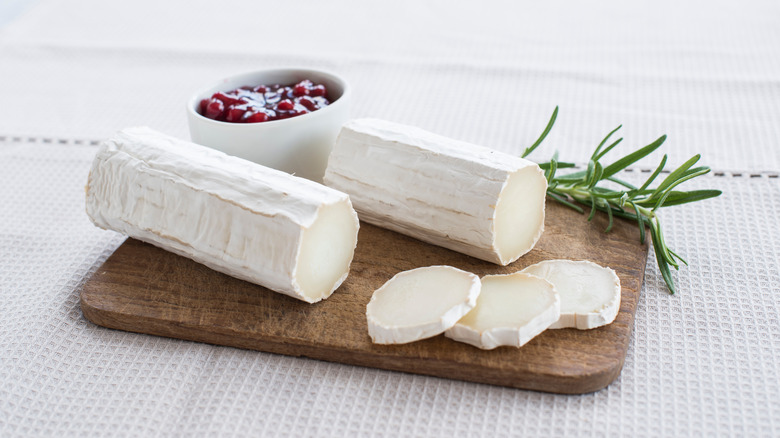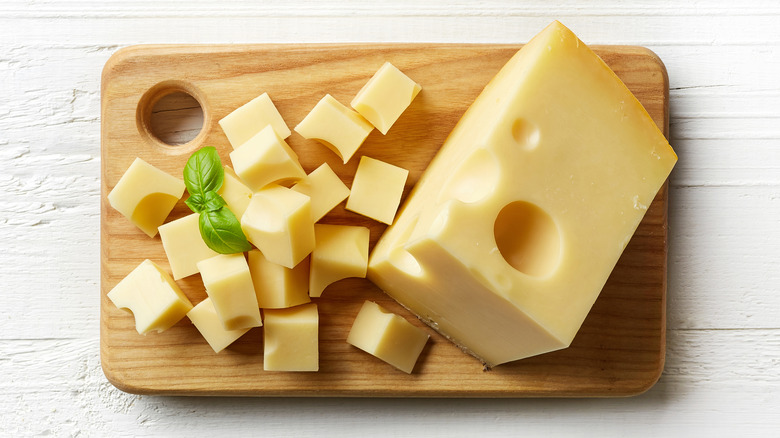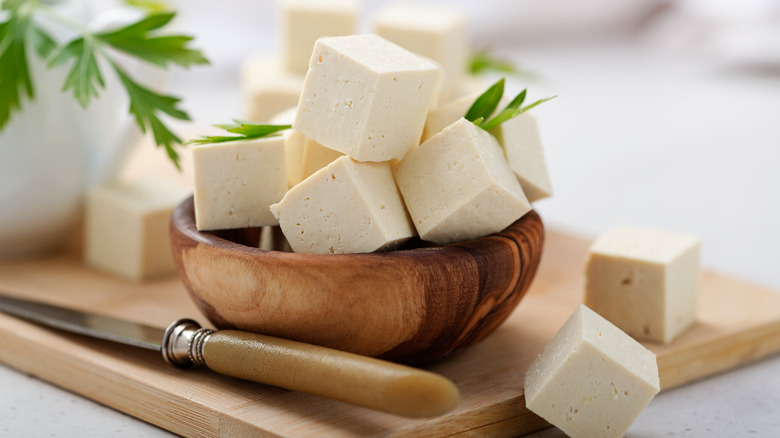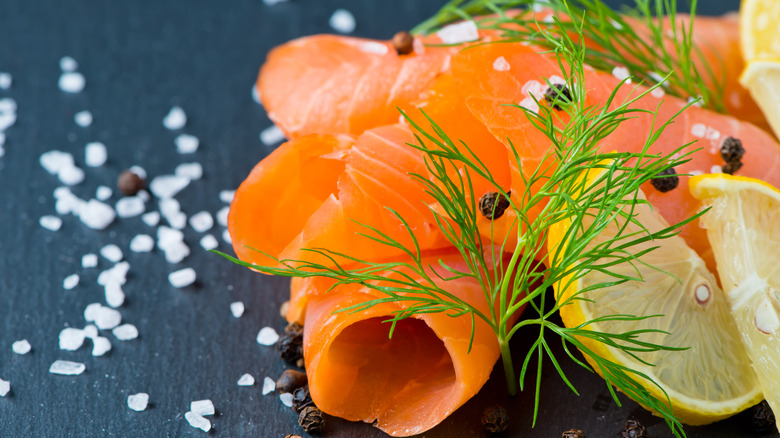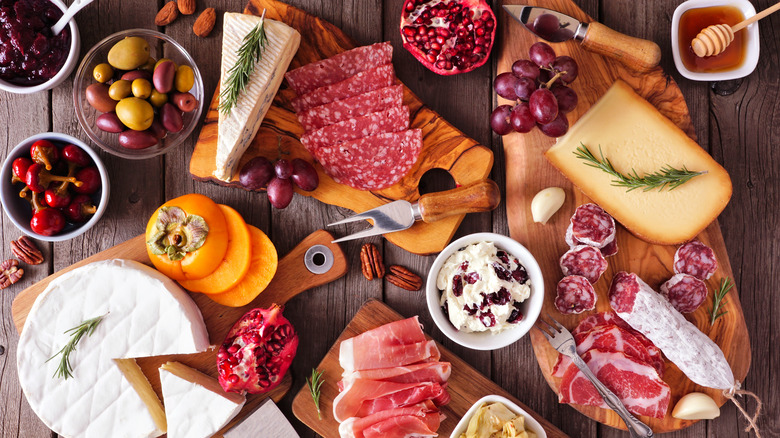The Best Types Of Meats And Cheeses For Your Charcuterie Board
When it comes time to entertain, there are few menu items that will bring people together better than a gorgeous charcuterie board. It's absolutely guaranteed to get even complete strangers talking as they compare goodies, recommend what others definitely need to try, and — hopefully — ask for more information on where you got all these wonderful, bite-sized morsels.
But that's if you do it right, and while there are no hard and fast rules about what a charcuterie board needs (and doesn't need), there are some important guidelines to keep in mind while making selections — and this comes with a caveat.
One of the most important things to remember, no matter what meats and cheeses you choose, is that quality is everything. If you're making, say, a casserole, you might be able to get away with getting a few ingredients of lesser quality, because it's all going to be hidden within the meal. That's not an option with a charcuterie board. Every piece is going to be eaten and savored alone or on something simple like crackers, so there's no hiding the quality of ingredients. Buy and serve only the best, and you'll really give your guests something to talk about.
Now, what should you be reaching for? These are the best types of meats and cheeses for your next charcuterie board.
Definitely include some cured sausages
Part of what's going to make your charcuterie board memorable is including something for everyone — no matter how adventurous or reserved someone's palate is, there should be something there they can reach for. When it comes to the more reserved side of things, chef Seamus Mullen of the El Colmado Butchery says (via Bon Appétit) that cured meats are a great way to go.
Who, after all, can pass up some slices of pepperoni? Sure, it's great on a pizza, but add some rolled sandwich-sized slices to your charcuterie board, and you're not going to go wrong.
There are many more options than just pepperoni, too. Add in some hot-and-spicy chorizo, or, if you're looking for something that's not quite as hot but just as flavorful, Crush says that saucisson sec is another great option. It's basically a salami-like meat that's heavy on the black pepper and garlic. Those are certainly flavors that don't require an adventurous palate to enjoy.
While many of your cured meats are going to be pork-based, you can definitely opt to mix it up with something called bresaola. That's made from beef, and you can find both smoked and unsmoked versions of this incredible sausage that's typically cured just with some salt and pepper. If you want to go one step further, pick up some morcilla, a cured blood sausage make from pork.
Include a selection of pre-sliced fancy ham
A truly phenomenal charcuterie board is going to have a variety of textures and flavors, and adding some pre-sliced varieties of thinly sliced, whole-muscle ham products is a great way to fill out a board with something salty. So, what does that include? One of the most popular choices is prosciutto, which is thin slices of dry-cured Italian ham. If you want to get really, really fancy, pick up some Prosciutto di Parma, which is made in a tightly regulated process that's been in place for around 500 years (via Crush).
Pancetta is another accessible, easy-to-find option. It's basically cured bacon, and everyone loves bacon, right? Speck is also a completely legitimate option, and it's made with a method similar to prosciutto. Making speck usually involves a top-secret recipe specific to the maker — pretty cool!
While prosciutto, pancetta, and speck are from Italy, there are also some delicious options from Spain, like Jamon Serrano. This pork product must be made from either Landrace or Duroc pigs and spend at least 8 months curing, while the similar Jamon Iberico can be aged up to four years and is generally considered one of the best pork products in the world. Just be sure that, whichever variety you choose, you do some research ahead of time. Slicing these the right way is going to make a ton of difference in just how tasty (and easy-to-eat) they are.
Meat pâté is a must-have
The word "pâté" simply means "paste," and that's a completely accurate description of what this is. When it comes to building a charcuterie board, pâté is an excellent way to include meat that's going to add a whole different texture to the platter. Steele House Kitchen calls it a must-have. It follows that you'll need something for your guests to use to spread it with, like a dedicated knife, as well as a vehicle of some sort, like crackers, or pita chips.
There are different types of pâté that you might want to try, too. According to The Spruce Eats, the terms "pâté" and "terrine" are often used to mean the same thing, so if you see either description while you're out shopping, either should work just fine.
Pâté comes in all different kinds — pork, beef, ham, and even seafood are all commonly used, but if you want something truly unforgettable, look for pâté made from liver. Why? Not only is liver full of all kinds of nutrients, but it's also been scientifically proven to provide an energy boost to those who eat it. Keep that party going!
Put out salami your guests can cut for themselves
A great charcuterie board will have something interactive that your guests will have to slice themselves. Not only will this be a conversation starter — "I'd love to try that, too, can you slice me a piece?" — but these are usually the types of meats that will add some serious texture to the board. They're usually harder meats, and that makes salami of all kinds a perfect choice.
We're not just talking about the sort of salami you might get with the intentions of making a sandwich, either. There are all sorts of different types, and this is a great opportunity to pick up a few different varieties.
British Charcuterie says that while salami has traditionally been made from pork, there are now a whole host of other options on the market, from duck and other wild game salamis to lamb and venison. Delicious recommends a green pepper venison salami for a meat that's going to have a nontraditional but not overwhelmingly gamy taste, while Good Food recommends something called hunter's salami. The name is slightly deceptive — instead of being made from wild game, it's actually made from pork (via Superior Meats). What sets this particular salami apart is that it has a hot and spicy kick from the addition of paprika, and it's a Hungarian salami that has been made this way for a long time.
Go ahead, try some lard!
A charcuterie board is an ideal way to serve your guests something they've never had before. There's no commitment, after all, and it's not like taking a risk on a full meal. If there's something they're not fond of, there's plenty more to sample — and that's where lard comes in. Chef Seamus Mullen of the El Colmado Butchery says (via Bon Appétit) that lard — which is basically the fattiest part of the meat — rendered down and served on crackers or toast is a brilliant way to add some creamy flavor to a charcuterie board.
Now, we're not suggesting giving your guests globs of fat to chew on. According to Chris Thompson of Denver's Hotel Teatro (via Food Republic), the best lardo is made in the fall, when pigs are at their fattest. Imagine a block of creamy, almost buttery fat that's been shaved into ultra-thin slices to allow it to just sort of melt in your mouth. When it's the truly good stuff, it should be pure white. Plus, since each serving is only going to be made up of the thinnest of slices, you can add just a relatively small amount and know your guests are all going to try some of this. And then? They'll be believers.
Something smoked will add a new flavor profile
Now comes the part when you're going to have to make a choice. While the addition of something that's been smoked is a must-have on any good charcuterie board, this is one case where it is possible to have too much of a good thing.
Elias Cairo is the owner of Olympia Provisions in Portland, and he's also an official salumist. (Yep, that's a thing!) Cairo has this to say when it comes to adding smoked meats to a charcuterie board (via Epicurious): "I like to only have one element of smoke — because I feel like if you eat smoked meat after smoked meat after smoked meat, it all kind of just tastes like smoke — so like some smoked ham, or a piece of smoked kielbasa."
You may also opt for something like andouille sausage, a traditional ingredient in Cajun cuisine. Andouille is a source of not just smoke, but heat and spice, too. Just be sure not to go overboard with the smoked meats, because variety really is key here!
Regional cheeses can spotlight your local farmers
This recommendation comes with a bit of a disclaimer: we can't actually tell you what you're looking for here. That's because, according to Olympia Provisions owner and salumist Elias Cairo, this one depends entirely on some important choices that only you can make. Cairo says (via Epicurious) that when he's choosing cheeses, he selects a region first. That might mean focusing on French or British cheeses, for example, then picking a soft cheese, hard cheese, and a funky cheese from that particular region.
We're going to go one step further, though, and recommend you don't look to some international, fancy-pants cheeses when it comes time to pick your region. Instead, look right in your own backyard!
Cooking Light says that when it comes to regional cheeses, there are some brilliant options out there. Look to the northeast and pick some aged cheeses from Vermont, add some spreadable pimiento cheese and serve it alongside some other award-winning cheeses from the south. You could also pick a selection of Tillamook Valley cheeses from the northwestern US, for instance. Is this also a chance to brush up on your geography trivia so you can share some fun facts about your region of choice? Yes, yes it is!
Goat cheese can be a fun addition
Cheese can be one of those very polarizing foods, and there's a lot of really weird ones out there. Consider, as CNN reports, the dust mite cheese from Germany, fermented mare's milk cheese from Asia, or even lichen cheese from Canada. It's easy to be tempted by some of these far-out types of cheeses, but what's the point if only a select few are going to try them, much less like them?
That's where goat cheeses come in. Canadian Living says that if you're looking for a creamy, soft, spreadable cheese (and you should be), then goat cheese is the way to go. Not only are they a little outside of the norm, but they also have a mild flavor that's different without being overpowering. They also tend to have a pleasing texture, and they're a great sort of non-traditional yet widely appealing type of cheese.
Another bonus is that if you want to get super fancy, goat cheese is easy to dress up to take it to the next level. Ciao Florentina says it's incredibly easy to form a log of goat cheese, then add an outer coating of ingredients. Press on a layer of toasted walnuts and drizzle with honey, for example, or use edible flowers for a bright pop of color. Fun, right?
Add an accessible hard cheese everyone will like
This goes back to making a charcuterie board that everyone's going to like, and for those who might tend to reach for the old, familiar favorites, NBC's Better suggests that you should definitely include some of those ultra-popular hard cheeses.
We're talking about things like Monterey Jack, Colby, Swiss, and different kinds of cheddar. Cut them into cubes and scatter a few piles of these cheeses within some of the more complicated cheeses, or slice them into cracker-sized flats to make them even easier to eat. You can also opt to pair these with some of those cured or smoked sausages you're probably already planning on including. Just cut them into similar sizes and serve two to a toothpick.
And if you're in doubt, just think of it this way: these cheeses are so widely available because they're popular, and they're popular because people love them! While offering new experiences is part of the fun of a charcuterie board, that doesn't mean there's no place for the regular staples. After all, you don't have to completely reinvent the wheel on your charcuterie board.
Offer your vegan (and non-vegan) guests a non-dairy cheese
There are plenty of reasons someone might steer clear of cheese, from difficulty digesting dairy to making the decision to go vegan. Whatever the reasons, it's a choice that's becoming more and more popular these days, and that means there's plenty of choices out there for vegan, plant-based cheeses that even dairy fans would love to try.
Most vegan cheeses typically start with cashews, which make them super creamy. That's definitely the case with The Frauxmagerie's Botanic Camembert, which is made with cashews and yeast, along with a healthy helping of probiotics. It's a cheese that will have even the most devout dairy-lovers asking for more!
There are also dairy-free options out there for cheeses like gorgonzola, gouda, and mozzarella, which means that not only will your dairy-free guests be excited to have something they can eat, but everyone will get the chance to try something new! The only bad part about this is that you're going to have to work extra hard to top your charcuterie game at the next party, because how do you beat something as creative, fun, tasty, and versatile as this?
Smoked salmon can be a refreshing addition
One of the nice things about experimenting with a charcuterie board is that there's really no wrong way to do it. That means you can have a lot of fun making them different every time. NBC's Better suggests that instead of just focusing on just traditional meats, opting to include smoked fish is something that's sure to create some buzz.
While there are different options for smoked fish, it's smoked salmon that's sure to be the biggest hit. BluGlacier says that any kind of smoked salmon can cut through what might otherwise end up being a pork-heavy charcuterie board. It'll add a whole new depth of flavor, too.! Also, it's pretty perfect if there's someone at the party who's a pescatarian. A charcuterie board is, after all, diversity on a platter, and there's no reason you can't cater to all your guests here.
Many of the accompanying ingredients you'll choose pair well with both pork and salmon, too. Things like cream cheese, crackers, olives and pickles, and even dates will go nicely on a charcuterie board, regardless of whether your guests reach for the salami or the salmon.
Now, here's some super important factors to keep in mind
Meats and cheeses are, of course, just a few components of a charcuterie board, and there are plenty of other things you're going to want to add, too. Anything your guests can move through and nibble on is a possibility, but Nutritional Therapist Steph Gaudreau says there are some things to keep in the back of your mind as you're making your choices or doing your shopping.
For starters, you're going to want to choose a variety of flavors. If you're picking both a smoky meat and a smoky cheese, add some bites that bring a sour, bitter, or tangy flavor to the board. You can also add something sweet, like candied nuts or dates. The same goes for textures. Many of the meats and cheeses you'll find on a charcuterie board require a bit of chewing, so be sure to add some crispy, crunchiness with crackers or pita chips.
Finally, consider temperature. While most of the meats and cheeses on your charcuterie board will be perfectly fine sitting at room temperature, think about adding an insulated dish with some baked brie, cocktail sausages, or slices of hot kielbasa. You could also go the other way, with cold preserves, butters, and fruits. Don't be afraid to get creative!
